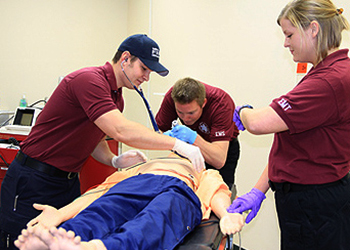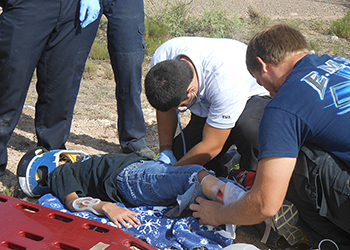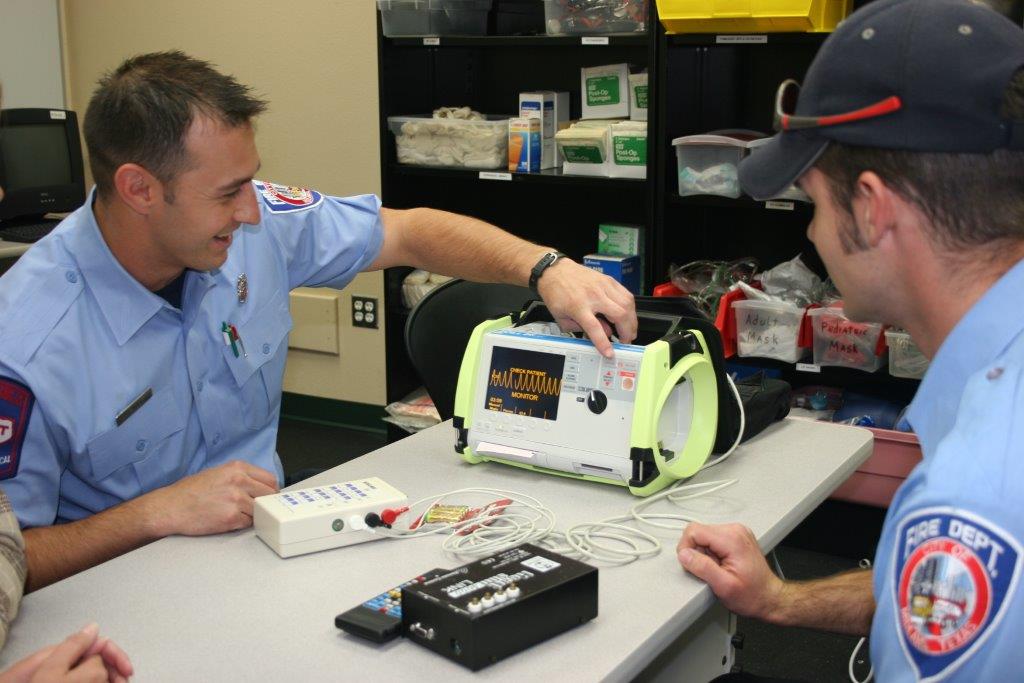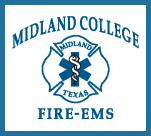Emergency Medical Services
Have you always wanted a career helping others? Can you work as a member of a team and remain calm in stressful situations? Do you have good interpersonal skills and could help people feel safe in scary circumstances? Do you have an overall positive attitude?
If you answer yes to these questions, your career choice might be to become an Emergency
Medical Technician (EMT) or Paramedic (EMT-P). Every year in the U.S., approximately
240 million 911 calls are made asking for emergency medical assistance. If you qualify
for one of the EMT programs at Midland College, you could be the one receiving a call
for emergency help and save a life.
Are you ready to begin?
 |
 |
 |
Education Pathways
The EMS Department at Midland College is a leader among educational institutions in the state offering EMS training. The EMT Basic and Paramedic programs are approved by the Texas Department of State Health Services. The Paramedic program is fully-accredited by the Commission on Accreditation of Allied Health Education Programs (CAAHEP) as recommended by the Committee on Accreditation of Education Programs for the Emergency Medical Services Professions (CoAEMSP).
Differences between EMT-Basic & Paramedic training
Paramedics have more education and training than EMTs. Being an EMT is a prerequisite to paramedic training. Students taking the EMT curriculum will spend about 160 clock hours in lectures and lab, go on ambulance ride-outs, and do assignments in hospital or community emergency departments.
Paramedic students spend over 1,000 clock hours taking lecture, lab, and clinical courses. Clinical training for paramedic students includes many hours in emergency departments and other hospital medical, surgical, and obstetric units. Paramedic students ride with EMS personnel on ambulances, perform skills, and participate in patient care.
One pathway to becoming a certified EMT (basic level) is to apply to take classes offered evenings in the spring and fall semesters and daytime in the summer. Two courses are required, and these can be completed in one semester. Students enroll in this pathway after meeting the admission requirements.
EMT training is available to high school students through the collaborative agreement with Midland Independent School District (MISD). Students begin EMT classes in the second semester of their junior (11th grade) year. Dual credit students will complete the program in two to three semesters. Dual credit students take EMT classes five days a week. Scheduling is compatible with their high school plan to complete diploma requirements. EMT classes are taught on the Midland College campus on Garfield Street. Register as a High School Dual Credit student.
Skills performed by EMTs include:
- Cardiopulmonary resuscitation (CPR)
- Managing airways for effective breathing
- Administering oxygen
- Using a bag valve mask ventilator
- Administering selected medications
- Immobilizing bone and joint injuries
- Assessing patients with medical needs
- Assessing patients who have experienced trauma
- Controlling bleeding and shock management
Students who complete the EMT-Basic training courses
with grades of “C” or better and meet all of the program requirements are eligible
to become a certified/licensed EMT if they:
- are at least 18 years old,
- pass a criminal background check,
- have proof of Basic Life Support (BLS) training, Healthcare Provider from the American Heart Association,
- pass the National Registry EMT (NREMT) cognitive exam (written), and
- pass the state-approved psychomotor exam (perform EMT skills).
Individuals meeting these requirements apply online to the Texas Department of State Health Services (TDSHS) for certification/licensure as an Emergency Medical Technician-Basic level.
Midland College offers an education and training program for EMTs who want to become paramedics (EMT-P). Paramedic students must hold the EMT-Basic or Advanced EMT license and meet program admission requirements. Students cannot take paramedic-level courses until they have earned their EMT-Basic or Advanced EMT certification. Still, they can take the two designated prerequisite courses, BIOL 2404 Human Anatomy and Physiology and HPRS 1106 Essentials of Medical Terminology. Graduates earn the college-level certificate (Certificate, Paramedic) in three semesters.
The paramedic curriculum focuses on knowledge and skills required in prehospital care, such as managing 911 emergencies in the ambulance and emergency centers. Paramedic students attain mastery in skills including, but not limited to:
- Patient assessment
- Endotracheal intubation
- Oxygen therapy
- Medication administration
- Shock management
- Bandaging and splinting
- Interpret electrocardiograms (EKGs)
- Cardiac and trauma management
- Medical emergency management
- Childbirth
- Pediatric emergencies
- Use of various types of equipment
- Trauma scene management
Students can earn an Associate’s Degree in Emergency Medical Services (A.A.S.), which has the EMT-Basic and Paramedic courses built into the degree plan along with general education courses in computers, math, psychology, English, and an elective in the humanities or fine arts. The A.A.S. is completed in five semesters. Some students work toward earning the A.A.S. after they become an EMT-P.
Students who complete the paramedic certificate and meet all program requirements, including earning grades of “C” or better, are eligible to become a certified paramedic (EMT-P) if they:
- Are currently licensed as an EMT,
- Pass a criminal background check;
- Have proof of Basic and Advanced Life Support training, Healthcare Provider from the American Heart Association;
- Pass the National Registry Paramedic (NRP) cognitive exam; and,
- Pass the paramedic psychomotor exam
Graduates of the A.A.S. degree program are eligible for licensure as a Licensed Paramedic, LP, when they meet all qualifications from the Texas Department of State Health Services.
Program Outcomes |
2021 |
2022 |
2023 |
| National Registry Written - Pass Rate | 92.6% 100% 90% 100% |
85.4% 100% 87.5% 100% |
78.6% N/A 90.3% 96.4% |
| National Registry Practical - Pass Rate | |||
| Retention | |||
| Positive Placement |
Join Our Program
Select Links Below for Details
Limited Enrollment
The EMS courses have limited enrollment based on resource availability. Applicants are notified of program acceptance by phone and email. Students are admitted into the EMT-Basic or Paramedic program shortly before a new group of students begins classes. A new paramedic class starts in January and June of each year. A new group of students in the EMT-Basic program begins in August, January, and June. The dual credit EMT-Basic students begin in August.
MISD high school students wanting to pursue EMT-Basic training must work with their high school counselors as well as the Midland College EMS department for admission into the program. The decision to be an EMT student has to be made by the spring of their sophomore (10th grade) year. MISD pays tuition and fees for dual credit students.
Requirements - Emergency medical technician (EMT)
-
Apply to Midland College
Students must have applied to the College through the Apply Texas website before their application to an EMS program can be finalized. Students accepted into an EMS program register for courses online.
-
Complete the Fire & EMS Program Application
Fire & EMS Program Application
- Tuberculosis screening
- Urine drug screening (as scheduled after classes begin)
- Criminal background clearance
- Health insurance coverage
REQUIRED VACCINATIONS
- Mumps-Measles-Rubella (MMR, 2 doses)
- Hepatitis B (3 doses)
- Influenza vaccine
- Varicella (Chicken Pox) - 2 doses or verification of disease
- Tetanus Diphtheria Pertussis (Tdap) - 1 dose within the last 10 years
Paramedic Requirements
- EMT Requirements, plus:
- Certified EMT and completed BIOL 2404 and HPRS 1106
- Current Red Cross Health Care Provider CPR card
All paperwork should be turned in once the Health Sciences General; Application is submitted.
Final admittance decisions made approximately 30 days prior to the first day of class.
Class Schedules
EMT students must be prepared to study hard and spend many hours in class, labs, and clinical. You are learning to help save people’s lives. Good attendance helps ensure success in EMT courses. Regular attendance is required. The attendance and tardy policy is strictly enforced.
EMT-Basic students can expect to be in class Tuesday and Thursday evenings from 6-10 pm in fall and spring semesters and 9 am - 3 pm Tuesday and Thursday during the summer. The schedule for dual credit students follows MISD class times, and students are on the MC campus approximately one-hour Monday through Friday.
Paramedic students can expect to be in class Monday and Wednesday or Tuesday and Thursday from 8:30 am - 3:30 pm during the fall and spring semesters. Summer courses are taught 8:30 am – 5:30 pm, Monday through Thursday. Note that the paramedic program is three consecutive semesters so all students will take summer courses.
Types of Instruction
EMS is not an online program. The majority of classes are taught face-to-face. Online learning programs are used in EMT and paramedic courses. Testing is typically done online. Students will learn to use the same types of equipment that EMS personnel use in the field. Learning skills is an important part of the EMS curriculum, and many hours will be spent in on-site labs under the supervision of licensed EMTs. EMT and paramedic students have hands-on experience with patients in healthcare settings and on ambulance ride-outs.
Adult students purchase their own books for the courses unless grant or scholarship funds are available. Dual credit students may have their books paid for with college or MISD funds. A few supplies are needed, such as a good quality stethoscope.
Professional Attire
EMT personnel are professionals in healthcare and public service industries. Professional appearance is a must. EMT students purchase their own uniform(s). Uniform requirements will be explained to students when they are accepted into the program.
What jobs can I get?
EMS personnel are primarily employed by licensed private and municipal ambulance providers, fire departments, hospitals, industrial safety departments, recreational facilities, and governmental agencies/departments. Employment is also found in EMS management, education, EMS marketing or sales, and departments within branches of the U.S. military. Registry and or licensure credentials mandated for employment in all levels of practice.
Is it likely I will find a job after completing the EMS program and how much money can I expect to earn?
CareerOneStop, sponsored by the U.S. Department of Labor, projects job growth increase of 29% for EMTs and paramedics, and 18% for firefighters, who often hold EMS credentials. The typical annual salary for a paramedic is $37,120 to $58,810. The annual salary for an EMT is $28,920 to $37,660. CareerOneStop estimates there will be 20,700 projected job openings annually for individuals trained as EMTs and paramedics.
Paramedic is the highest level of licensure in the emergency medical services profession. Many municipal fire departments, such as the Midland Fire Department, employ only firefighters who are paramedics or who can obtain the training in a short time after employment. These needs, seen locally and beyond, create a demand that almost guarantees a job to all graduates.
What credentials can I earn after becoming an EMT-P?
Paramedics who are graduates of associate degree programs, such as the degree offered at Midland College, are eligible for licensure in Texas at the Licensed Paramedic (LP) level. Bachelor’s and master’s degrees are available at several universities for interested students. Midland College offers two bachelor’s degrees that paramedics seeking positions in management or leadership might be interested in: B.A.S., Health Services Management with an emphasis on healthcare administration, and the B.A.T., Organizational Management.
What kind of working environment can I expect?
EMTs and Paramedics have rewarding and challenging jobs. Many individuals work in organizations that are open 24/7. Irregular work hours will require an adaptable family life. Firefighter paramedics are required to sleep at the assigned fire station when on shift. Work is done inside and outside and in all kinds of weather. Emergency personnel continuously kneel, bend, and lift patients and heavy equipment. Physical fitness is required for personal safety. Exposure to contagious diseases is a risk, as is receiving unpredictable reactions from people who are stressed or in pain. Good communication skills are necessary because the EMS team must know patients’ needs and problems, as well as how to proceed with interventions.
Watch the video produced by CareerOneStop for more information:
Marketable Skills
Pursuing a certificate or degree in this field of study will provide marketable skills in these areas:
- Service Orientation – Providing active and proactive assistance to those in need
- Critical Thinking – Using intellectually disciplined thought processes to determine appropriate treatment options based upon patient signs, symptoms, and situations
- Active Listening – Listening to others, not interrupting, and asking good questions
- Judgment and Decision Making – Evaluating different options and selecting the most appropriate plans of action
- Operation and Control – Using equipment or systems
- Time Management – Prioritize workload to attend to the most critical needs first, and if needed, be willing to ask for help
- Written Communication - Demonstrating complete, accurate and effective professional documentation on paper, computers, or electronic devices
- Monitoring – Keeping track of how well people and/or groups are doing in order to make improvements
- Oral Communication – Speaking with clarity and precision with a diverse population and recognizing non-verbal cues
- Professionalism/Work Ethic – Demonstrating personal accountability and effective work habits
To be considered for a scholarship, please follow the link below:
Visit the course catalog for the most complete and up-to-date information.
Licensing body for this program
Texas Department of State Health Services
To request a review of the impact of criminal history on your potential EMS license prior to or during your quest for a certificate or degree, visit the department’s website and request a Criminal History Evaluation. You are invited to speak to your instructor or the Department Chair should you have questions.
Texas Department of State Health Services
PLEASE NOTE: Completion of Midland College degrees and/or certificates does not guarantee eligibility to take a certification/registry/licensure examination. The eligibility of each person is determined on an individual basis by the regulatory body of the specific discipline. If you have a conviction of a crime other than a minor traffic violation, physical or mental disability/illness, hospitalization/treatment for chemical dependency within the past five years, current intemperate use of drugs or alcohol or a previous denial of a licensure or action by a licensing authority, you will need to contact the specific regulatory body for an individual ruling. Some programs require a criminal background check and urine and drug screen.
Why study EMS at MC?
|
|
|
ContactDepartment Chair Mark Kuhn Location Harris Training Field FacultyEmergency Medical Services & Fire Science Technology Faculty Contact Information |
Division OfficeApplied TechnologyMarie Hall Academic Building |
Related Programs |
Related Resources |
Apply to MC Now
Thank you for choosing Midland College! If you are here to collect a few credits, take courses to transfer, or here to start a new career, we welcome you.
